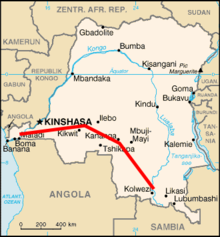HVDC Inga-Shaba
The HVDC Inga-Shaba is a high-voltage direct current transmission line (HVDC) in the central African state of the Democratic Republic of the Congo , formerly Zaire , and is used to conduct electrical energy from the west of the country to the southeastern and resource-rich province of Katanga for copper mining.
The HVDC line begins near the Inga Dam ( 05 ° 31 ′ 27.0 ″ S , 013 ° 36 ′ 39.0 ″ E ) and ends after 1700 km in the southeastern province of Katanga , formerly Shaba, in the city Kolwezi ( 10 ° 39 '27.0 " S , 025 ° 27' 08.0" O ). It is the longest overhead line in Africa with the special feature that, due to the largely difficult-to-access terrain, a separate route with a correspondingly large space requirement was selected for each pole .

A special feature of the HVDC Inga-Shaba is that, if necessary, the polarity of each pole can be switched, which allows operation in the form of two monopoles connected in parallel. In this case, the entire energy can be transmitted through one pole of the line, which increases the availability of the system. Partial decommissioning of a pole is also possible, because the HVDC Inga-Shaba has intermediate switching mechanisms at which line sections can be switched off or connected in parallel. However, no power can be taken from the line at these systems, which are located at Selo, Kikwit, Kananga and Kamina, as no power converters are installed in these systems.
The line is designed for a transmission power of 560 MW and can be operated as a bipolar or optionally with half power, as a monopolar HVDC transmission with a direct voltage of ± 500 kV . Construction began in 1973; due to social unrest, the transmission system could not be put into operation until 1982 with 10% of the projected output. The builder of the system is Asea Brown Boveri (ABB). In the 1990s, the transmission capacity was increased to around 200 MW.
Individual evidence
- ↑ Inga-Shaba HVDC References ABB, (engl.)
